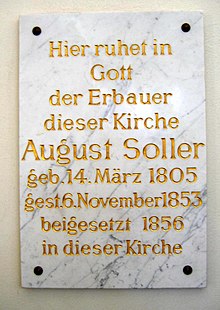August Soller
| Johann August Karl Soller | |
|---|---|

Soller's grave inscription at Saint Michael's Church, Berlin, 1856
|
|
| Born |
March 14, 1805 Erfurt, Principality of Erfurt |
| Died | November 6, 1853 (aged 48) Berlin, Kingdom of Prussia |
| Alma mater | Bauakademie |
| Occupation | Architect |
| Spouse(s) | Friederike Wilhelmine |
| Children | 8 |
| Buildings |
Luisenstädtische Kirche St. Michael's Church, Berlin |
Johann August Karl Soller (14 March 1805 – 6 November 1853) was a Prussian, and later, German architect. He was one of the most important of Karl Friedrich Schinkel's pupils and is regarded as a representative of the Schinkel school. Soller became an influential proponent of Rundbogenstil, a Romanesque revival architectural style that became popular in German-speaking lands and among German diaspora during the 19th century.
August Soller was born in Erfurt, Principality of Erfurt, in 1805. He worked as a land surveyor from 1820–1822 and completed his surveyor's examination on June 22, 1822 at the E. S. Unger Mathematical Institute. Soller then completed two and a half years of practical experience as a building inspector. To prepare for his master builder's examination, he moved to Berlin and lived with the family of his nephew Richard Lucae.
In 1829 Soller was licensed as a Prussian state architect. He then served in the provinces, particularly in the Province of Silesia. From 1830 to 1833 he worked as a royal construction foreman for the District Government in Liegnitz and for a time served as a construction inspector in Posen. His focus became the design of churches and the supervision of their construction. On June 1, 1833, he became a master builder for the Prussian Higher Council of Architecture (German: Preußische Oberbaureputation) in Berlin and also became a member of the Berlin Academy of Architecture, known as the Bauakademie. During this period Soller was assistant to Karl Friedrich Schinkel, one of the most prominent architects in Germany. Soller took over the Department of Churches in the Construction Commission in 1841, and in 1843 was made Senior Privy Councillor (German: Geheimer Oberbaurat) for Infrastructure. From 1851 onwards he served as Lead Councillor for construction in the Prussian Ministry of Trade.
...
Wikipedia
